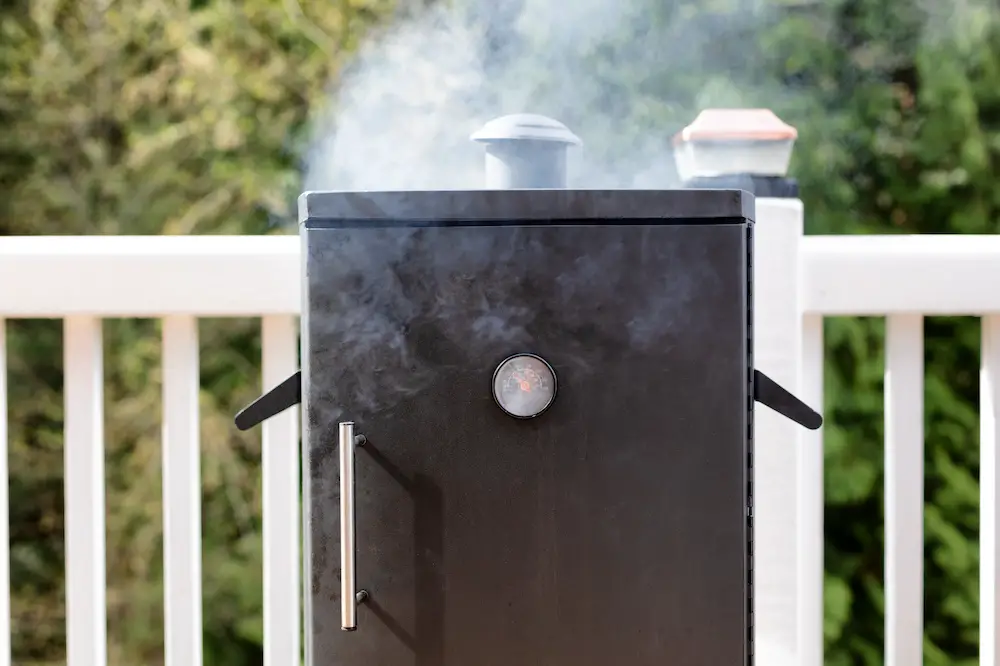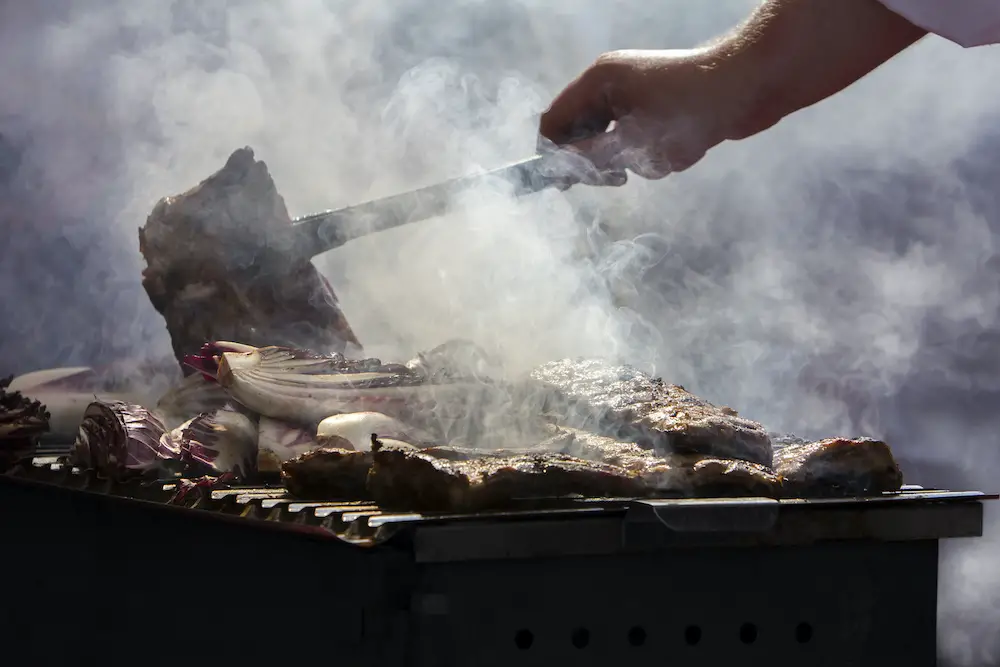
There’s nothing like a rack of tender, smoked, melt-in-your-mouth ribs.
Whether you like yours dry, or glazed with BBQ sauce, the smoky flavor is the most important aspect.
If you get that right, you’re sure to impress at every BBQ party.
Apart from that, while cooking barbeque, there are a lot of factors you need to keep in mind, such as the internal heat, level of smoke, and the type of smoking wood.
If you’re a newbie looking for the perfect technique to cook up delicious barbeque ribs that’ll make your day, you’ve landed on the right page.
We’ve compiled the complete guide about how to smoke ribs in a gas smoker and provides essential information about gas smokers.
What Is a Gas Smoker?
Before we get to the main smoking technique, beginners need to know the basics of the structure of a gas smoker and how to use it.
As a barbeque enthusiast, you must’ve come across a propane vertical gas smoker.
This type of gas smoker has a burner at the bottom that provides the heat needed to cook your meat and burn your wood chips.
Above the gas burner, there’s a metal pan or tray, depending on the make and model.
This pan give you a container to place your desired type of wood chips for smoking and receive the heat from the burner and transfer it to the wood, making it smoke.
Eventually, as the smoke reaches your meat, the flavor sinks into it, and you get that amazing barbeque flavor your love.
Another thing to remember is that you do not want to dry smoke your meat.
That’s why gas smokers have a separate water pan, which makes sure the environment inside the smoker does not get too dry to keep your food moist and tender. The water bath also catches the fat drippings so that they do not fall on to the smoking wood layer and start a wood fire.
Apart from the bullet-shaped gas smokers, you’ll find other types of gas smokers.
While the shapes and sizes are different, the operation process is more or less the same in every model.
Note: most links in this article are Amazon.com Affiliate links, see Affiliate Disclosure, thank you.
Advantages and Disadvantages
There’s a variety of smokers available in the market, all designed to give you the perfect barbeque experience.
Electric smokers are accessible and easy to operate, and pellet smokers are convenient and easier to operate for long periods of time.
So why should you learn the proper way of smoking ribs in a gas smoker?
Just like each type of smoker has a different structure and fuel usage, each of them has its advantages and disadvantages, as well.
Here’s a list of pros and cons of a gas smoker to help you make your decision whether or not to smoke your ribs inside one.
Pros:
- Burn clean, only giving out water and carbon dioxide
- Portable
- Easy to set up for an outside barbeque
- Easy to control the flame from high to medium-low
- The temperature can be regulated immediately if your food starts burning
Cons:
- The flame is controllable, but it’s difficult to turn it down without putting it out completely
- Sometimes, LPG gives a foul odor and taste to your food
- difficult to get low temperatures
How to Select the Best Ribs for Smoking
If you think the advantages of using a gas smoker outweigh the disadvantages, it’s time to choose your ribs.
The debate between beef and pork ribs has been going on since anyone can remember.
While both of them are delicious, which one is the better choice for smoking?
Why Go for Beef?
When it comes to barbeque ribs, most people, especially Texans, would go for beef by default.
With beef short ribs and yummy beef brisket, what’s not to love?
While the taste and texture speak for themselves, beef is a little difficult to cook as compared to pork.
Beef ribs take longer to cook than pork ribs because they’re larger in portion.
Besides that, they can become tough very quickly.
One mistake while smoking your beef, and you can end up with chewy, tough ribs.
Apart from that, beef short ribs, which are best for smoking, are way more expensive than pork ribs.
However, if you’re an expert at smoking beef ribs and don’t mind the extra price, beef ribs are certainly delicious and flavorful.
Why Go for Pork?
Naturally, as the animal is smaller in size, pork ribs are smaller than beef ribs.
This makes it easier to accommodate in your smoker.
Also, you don’t need to be a barbeque expert to cook pork ribs perfectly.
Most importantly, pork ribs are versatile.
Additionally, since they’re small, they have a slightly sweet flavor.
This makes it easy to incorporate different spices and create lots of recipes.
Besides smoking, pork ribs can be baked, grilled, or roasted.
On the downside, if you love the strong meaty flavor, you won’t get that with pork ribs.
Since the meat is less fatty as compared to beef, it lacks that strong, meaty flavor.
Lastly, pork ribs are cheaper than beef ribs. So unless you’re going for a high-scale barbeque party, pork ribs will do just right for your weekend family barbeque.
How to Smoke Ribs in a Gas Smoker
Since you’ve already chosen your smoker and selected the ribs you want to smoke, let’s get to the main process: smoking ribs!

1. Prepare Your Meat
Pat the meat dry with a paper towel, and then remove excess fat with a sharp knife, but make sure not to touch the fat between the bones, as they provide the moisture needed during smoking.
After that, remove the inner side membrane, AKA the silver skin. Some people like to leave it on, but that is just a bad idea. The silver skin can get chewy and prevent the smoke from penetrating the meat.
Peel up a corner of the silver skin and grab it with a paper towel. Slow pull it at a 45 degree angel from the meat and if your lucky it should come off in one piece.
Then, rinse and pat dry; your meat is ready for the rub.
2. Rub and Marinate the Ribs
A spicy, flavorful rub is the ultimate secret to the perfect barbeque ribs.
The smokey flavor accentuates the spices to give that heavenly taste you love.
Our favorite ingredients are smoked paprika, salt, garlic powder, onion powder, black pepper, cayenne pepper, and some brown sugar for that glaze.
Don’t go overboard with the ingredients, though, because when you’re smoking, simplicity is the key.
Mix your chosen spices in a large bowl then rub the spices generously over your rack of ribs.
After you’ve covered the ribs completely, set them aside in your refrigerator for about 24 hours to let the spices sink in.
3. Start Smoking
On the barbeque day, take your ribs out of the refrigerator an hour, maximum, before cooking.
You’ll need to preheat your gas smoker to low heat, about 220 - 225 degrees.
Check the temperature on the thermometer attached to your gas smoker.
Apart from that, it’s a good idea to use your cooking thermometer to check the temperature since it’s more accurate.
Pro Tip: gas smokers tend to rise in heat over time so check on it every ten minutes and they will drop in temperature when you reload the wood chips.
Once the ribs are at room temperature, place them on the rack of your gas smoker.
Remember that the meaty side goes up.
Now, let the ribs smoke for about four to five hours.
You can choose any kind of wood you like for smoking:
- Oak or maple works great with beef
- Pork tastes heavenly when cooked with apple wood
- Besides that, you can choose from hickory, pecan, and cherry wood.
For more details about selecting the right wood to match your meat click here to read our article.
After three hours of cooking, remove the ribs and place them on an aluminum foil sheet.
Make a mixture of lemon and apple juice, and pour it over the ribs.
Pack the foil up tightly once again, and place the foil wrap inside the gas smoker for two more hours.
4. Plate Your Ribs
Take out the cooked rib packages from the smoker.
Open the packages and set the ribs aside.
Pour the juices from the foil sheets into a large bowl.
Mix these juices with barbeque sauce, honey, and brown sugar.
Slather and glaze your ribs with the sauce using a brush, and place them once again, uncovered in the gas smoker.
Let them cook for another half hour and keep glazing them at ten-minute intervals.
Finally, take them out on your plate and enjoy!
5. Upgrade Your Skills and Try Out New Recipes
When it comes to developing expertise in the art of smoking food, reading smoker tip articles is an indispensable and efficient way to enhance your skills.
Our website offers a plethora of well-researched and comprehensive articles specifically tailored to help smoking enthusiasts refine their technique.
- 19 Tips and Tricks for Achieving Smoky Perfection with Your Propane Smoker
- How the Masterbuilt Propane Smoker’s Features Help You Master Smoking Techniques
- Mastering Propane Smokers: The Best Smoking Techniques, Flavors, and Tips for Beginners
- How to use a Masterbuilt Propane Smoker: A Beginners Guide
However, for those seeking extensive sources, the internet serves as an invaluable resource with a vast array of information from reputable websites, forums, and blogs dedicated to the subject.
Exploring different platforms can provide diverse perspectives, tips from experienced smokers, and even innovative techniques that may not be featured on our website.
Coupled with our own collection of informative articles, this combination will undoubtedly fuel your passion for creating delectable smoked dishes while elevating your proficiency in the craft.
Conclusion
So, how to smoke ribs in a gas smoker?
While smoking ribs is not rocket science, if you have a passion for cooking and serving the best for family and friends, the task will become easier for you.
Simply put lots of love into the recipe, prepare a hearty blend of spices, choose the correct smoking wood for your meat, and pay heed to operate your gas smoker properly.
At the end of it, you’ll have a rack of steamy smoky barbeque ribs.
Eat your heart out, and enjoy it!
